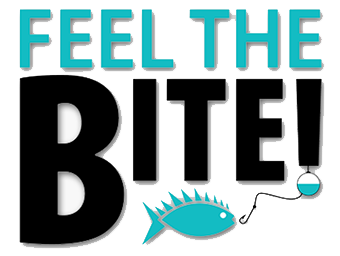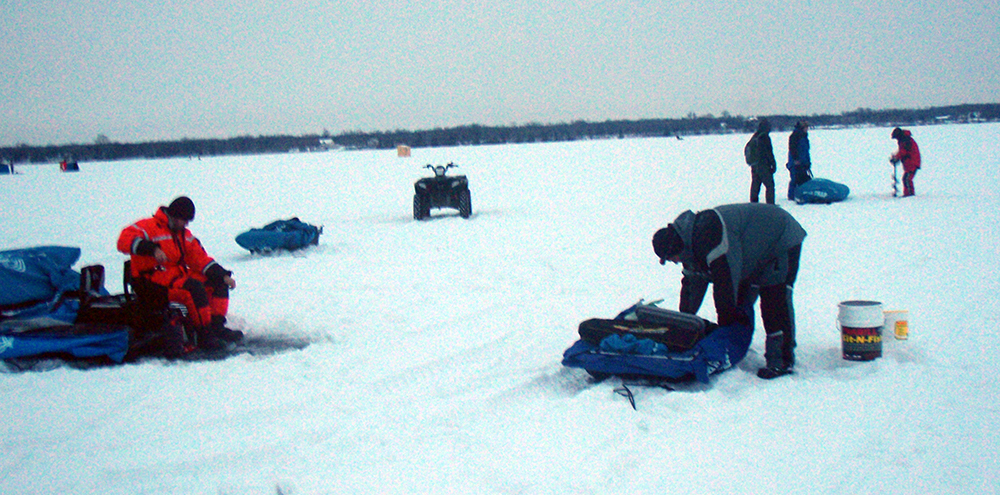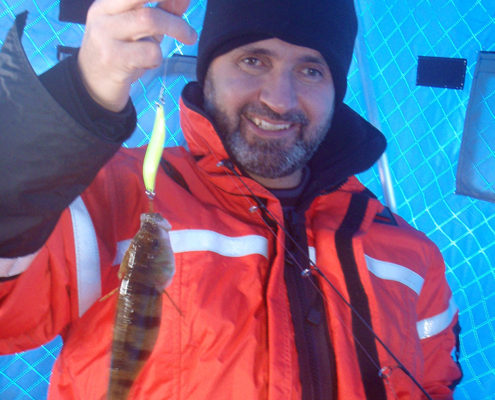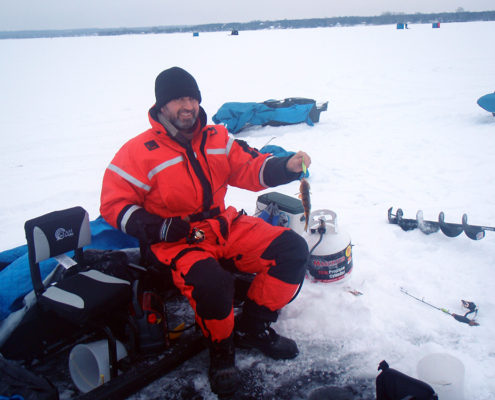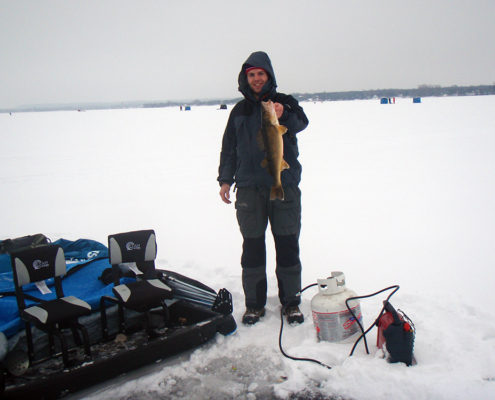Ice Fishing on Bay of Quinte
We’ve all heard about the Bay of Quinte and its monster world-class Walleye fishery, and many of us have tried their luck. Walleye move in from Lake Ontario in late fall to prepare for the spring spawning run up the rivers, providing for some incredible open-water action in October through to December, and then later through the ice. However, with its broad expanses, numerous bays and hidden currents, it can not only be a tough nut to crack, but in the winter a dangerous one as well. Venturing forth with someone who knows the territory is highly recommended, and professional guiding services like those offered by G2 Angling can help stack the odds in your favour. Three weeks into this year’s ice fishing season, two friends and I decided to try our hand and contacted Grant McAllister of G2 Angling (Tel: 647-982-FISH (3474)) “www.g2angling.com”.
Jim Wilson, Scott Campbell and I set off Friday night to over-night at the Twin Peeks Motel in Napanee. G2 has arranged for client discounts with the Peek’s proprietor, Ali, (Tel: 613-354-4066). Meeting up the next morning was simple as Jamie, our G2 guide for the day, planned the rendezvous with G2’s clients in the Peek’s parking lot. After a quick stop at Timmy’s for coffee, we were unloaded and ready to set foot on the ice by 6:30.
Equipped with a powerful ATV, Jamie hauled on to the ice the four Clam flip-over Nanook shelters and cargo sled full of propane heaters and tanks, Vexilar flashers, minnow buckets, electric auger and tackle. I volunteered to be the first client to be brought out. Being deposited on the ice and left alone is a cool feeling, especially when you can’t see a thing.
As a person without sight, I get a real thrill from venturing on to a featureless landscape like a calm lake, or in this case, miles of frozen ice. As the sound of the ATV faded, all was silent. Naturally, I couldn’t help but think about what would happen if Jamie never came back. How would I find my way off the ice without my Mountain Bernese guide dog, Maestro? A thrill in deed, but one I’m more than use to experiencing from being on the water in the world’s first, “Blind Fishing Boat” (www.blindfishingboat.com).
It wasn’t long before my ears adapted to the silence and I could detect the sound of a manual auger scraping its way through the ice off to my left about 100′, followed not long afterwards by the sound of a zipper door on an ice shelter about 50′ to my right. O.K., I wasn’t alone after-all, but the feeling was fun while it lasted.
The rest of our party of five soon joined me and it wasn’t long before Jamie had the wholes drilled, Vexilars set up, rods out and Clams flipped over. I tied on a chartreuse Perch 3″ 3/4 oz Lindey Viking spoon and tipped it with two lively minnows hooked through the snout. Scott Campbell, my shelter buddy for the day, was using a similar rig only his spoon had a rattle. The 28″ medium powered rods we were issued seemed to have plenty of backbone to get the job done, and the reels, loaded with 10lb ice brade and finished with a 2′ 8lb fluoro leader tied on with a miniature swivel, promised to provide plenty of tactile feedback and rock-solid hook-sets.
G2 makes use of all manner of electronics to put their clients “on fish.” From Navionic maps running on hand-held GPS units to locate features and previously recorded waypoints, to underwater cameras to identify structure and the presents of fish, to the latest in flasher technology to keep their clients focused on the task at hand.
Now, some might wonder how a fisher without sight like me is going to benefit from a flasher? It’s generally one of those questions that go unasked, just like the 800lb gorilla in the room no one wants to point out. Will I be able to catch fish as well as the person sitting next to me using the flasher, or will feelings of sympathy ruin the day as fish after fish are reeled in as I’m left jigging an empty hook?
There’s no doubt flashers make a difference, especially when fish are in a neutral mood and need to be teased into sampling one’s offerings. But I think the main purpose they serve is to focus the fisher on visualizing their presentation. Let’s face it, there isn’t a lot to look at sitting in a shelter or when ice fishing in general. And yet, detecting that bite, which in many instances is little more than a whisper in the wind, takes one’s utmost concentration. We can all be found guilty of day-dreaming from time to time, so any device that can keep our focus on the task at hand is a good thing.
It wasn’t long before the 800lb Gorilla squatting on the ice with us was sent packing as I caught the first fish of the day. While it may not have been that 10lb-plus Walleye we all dream of, it was still a fish. More importantly, it served to further increase our collective sense of anticipation over what the day might hold in store.
The Bay of Quinte is huge and its bottom relatively flat and featureless. Walleye seem to be constantly on the move, and to catch their attention one needs to jig quite vigorously. Snapping one’s presentation up 2′-plus feet and then dropping the bait directly on to the bottom to stir up some silt with every ten or so jigs can attract Walleye and raise them off the bottom. Once a Walleye has lifted off the bottom to more closely inspect a bait, it’s recommended to switch to a subtle quiver presentation; keeping your bait just above the fish. The higher you can draw a Walleye up off the bottom, the better your chances of the fish striking.
During the hard-water season government regulations permit two lines per angler. The practice of “dead-sticking” a minnow on a tip-up 20′ or so feet from where you are jigging is a tried-and-true favourite. It’s often the case that Walleye called over by aggressive jigging elect instead to dine on the less active suspended presentation. The introduction of flashers has simply resulted in the combining of the two-line method — Jigging vigorously to draw fish over and, once identified on the flasher, teased into biting.
The next fish to find its way on to the wrong side of the ice was a decent 4lb Walleye caught by one of the two lads hailing from Woodstock. The morning bite is generally the best time of day for icing lunkers, but as time passed and the heavy cloud cover was replaced with bright sunlight, our feelings of hope gradually switched to that of determination as the Walleyes brought up steadily diminished in both size and numbers. Our attention then switched to ensuring hooks weren’t stripped of their minnows by some of the chubbiest and light-biting Perch I’ve ever encountered.
By noon Jamie had had enough, and we readied the wagon train for transport still further out into “Big Bay” as reports filtered back through G2’s extensive scout network that Walleye were holding in waters deeper than the 20′ we were now positioned over. Before moving, Jamie ventured ahead to make sure ice conditions were stable as it can happen easily enough on the Bay of Quinte that currents can turn 6″ of solid blue ice into 3″ within a matter of 10 feet.
Unfortunately, the three low-pressure fronts that pushed through the region consecutively over the past four days left the Walleye feeling less than cooperative. All fish will feed actively when atmospheric pressure begins to drop prior to storms rolling in as fish have no idea whether the coming storm is small or about to turn their pristine environment into a soupy mess; making locating the next meal difficult at best. After such feeding frenzies or in our case likely three such dinner bells, it’s easy understandable that fish may feel somewhat sated.
Starting at around 2 p.m. activity under the ice increased significantly with schools of bait fish making brief appearances on the Vexilar and, what turned out to be Perch, ascending the entire water column to peek out through our fishing wholes. Walleye too became more numerous as one after another stopped, rose up off the bottom to inspect our offerings for as much as five minutes at a time, and then dropped back down to continue their roaming.
Very light biting Perch still managed to get themselves hauled out, and by the end of the day we had a nice assortment of good eating sized Walleye and some of the larger Perch caught that day. No big bruisers like the 10lb 2oz Walleye I caught trolling these same waters just two months prior, but we all no they are there and, without doubt, we’ll all be back to try our hand again. Oh yes, with respect to the Gorilla, I went neck-and-neck with the flasher “addicts”, and even better, suffered no apparent eye strain related fatigue. Now I’m not saying I wasn’t caught up in the “cat-and-mouse” games unfolding under our very feet as the blow by blow details were articulated to me by Scott, but I think I proved once again that a properly jigged presentation can hold its own. It could also be the case that my dependence on the sense of touch may have contributed to my success.
A big thanks to Jamie and Gary from G2, to Ali at Twin Peeks, and to Jim Wilson and Scot Campbell for joining me on this adventure. The Bay of Quinte hasn’t seen the last of us for sure.
